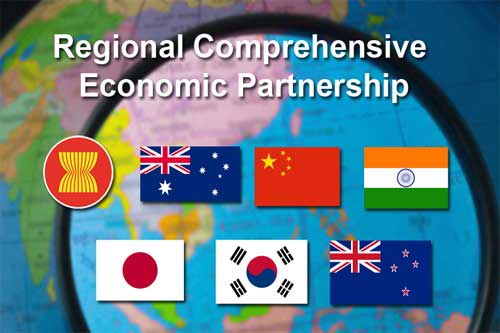Abstract
Indian livestock sector with its vast animal genetic resources and highest milk production continues to provide livelihood & employment for rural masses. The proposed Regional Comprehensive Economic Partnership (RCEP) agreement would destroy the Indian dairy sector by importing cheap dairy products resulting competition in domestic market. India has expressed its concerns over lowering and elimination of tariffs on products from other countries, as it would negatively affect the domestic dairy sector. India decided not to finalize the RCEP trade deal considering interest of farmers and dairy industry.
Introduction
Livestock sector is an important sub sector of the agriculture of Indian economy. It is one of the important socio-economic resources for alleviation of poverty and raising the standard of living of millions in the rural areas (Kumar et al., 2019). Livestock sector share 4.1% to National GDP and 27.4% of total Agriculture GDP at constant prices (BAHS, 2019). The share of livestock in the value of agricultural production has increased even while agricultural GDP has declined in its share. In the recently held Regional Comprehensive Economic Partnership (RCEP) Summit in Thailand, India decided not to finalize the RCEP trade deal. India has expressed its concerns over lowering and elimination of tariffs on products from other countries, as it would negatively affect the domestic dairy sector.
What is RCEP?
The Regional Comprehensive Economic Partnership (RCEP) is a proposed agreement between the member states of the Association of Southeast Asian Nations (ASEAN) and its free trade agreement (FTA) partners. It includes 10 ASEAN members and 6 FTA partners of ASEAN [The ASEAN member countries are Thailand, Indonesia, Malaysia, Singapore, Philippines, Vietnam, Brunei, Myanmar (Burma), Cambodia, Laos.] (FTA Partners are- India, China, Japan, South Korea, Australia and New Zealand). RCEP member states accounted for a population of 3.5 billion people with a total (GDP) of $49.5 trillion, approximately 39 percent of the world’s GDP.

A few days ago India decided against joining the Regional Comprehensive Economic Partnership – RCEP. In the run up to the RCEP meet, the domestic Dairy Industry has been vocal about its apprehensions regarding this FTA. It is not that the (dairy) industry alone would be affected, it will be affecting basic agriculture. The dairy industry is the ATM card for the villagers. India has been the leading producer and consumer of dairy products with a sustained growth over the years. Milk production of India during 2017–18 is 176.3million tones and it reached 187.75 million tonnes in 2018-19 showing an annual growth rate of 6.5%. Per capita availability of milk was about 394 grams per day in 2017-18 (DAHD, 2018-19). As the deal offered zero-duty imports of cheaper dairy products, the sector was concerned about heavy competition in both price and technology. Indian farmers are paid an estimated 60% of milk prices whereas it is only 23% and 24% in New Zealand and Australia respectively.
What makes milk and milk products such a big deal for India?

- Milk is the country’s largest “crop”.
- In 2018-19, production of milk is 187.75 million tonnes (mt), was more than that of paddy (174.63 mt) or wheat (102.19 mt).
- Milk is, moreover, a source of liquidity for farmers, as it is sold daily and generates cash to take care of routine household expenses, unlike other crops that are marketed only once or twice a year.
- But milk matters equally to consumers in India, because it meets the animal protein/fat requirements of a significant portion of the population that is vegetarian.
- Milk, in the Indian context, is also a ‘superior’ food with income elasticity of demand greater than one. This means that as incomes rise, the demand for milk goes up even more.
Why is the Dairy Industry apprehensive?
If India signs the RCEP, without exemptions for dairy and its products, it would allow the dairy industry of Australia and New Zealand to unfairly target its huge market.
- Will lead to unemployment and worse living conditions – There are 70 million households dependent on dairy in India, the corresponding number is just 10,000 in New Zealand and 6,300 in Australia.
- The unit cost of milk production is relatively low in countries like New Zealand because of extensive grazing lands (which reduce feed costs), mechanised operations and the advantages of economies of large-scale production, and the high productivity of milch animals.
- According to estimations made by Amul, if free imports of skimmed milk powder from New Zealand are permitted, the average price for milk received by an Indian dairy farmer would fall to ₹19/l (presently it is ₹30/l).
- India’s average bound tariff for dairy products is about 63.8% while its average applied tariff is 34.8%. Joining RCEP would have bound India to reduce that level to zero within the next 15 years.
Duty %
Import (Rs Cr)
Milk Powder 60
8.55
Butter/Fat 40
14.27
UHT Milk 30
12.69
Yogurt 30
6.56
Cheese 30
70.85
Whey 30
85.57
Ice cream 30
24.8
India’s Dairy imports Duty Structure (Ministry of Finance & Dept, of Commerce, GoI)
- India’s trade deficit with the RCEP nations is $105 billion, of which China alone accounts for $54 billion.
Export Import 2010-11
1216.76 847.83 2011-12
647.79 1219.41 2012-13
2324.68 184.25 2013-14
4407.78 232.68
2014-15 2169.03 375.01
2015-16 1677.46 371.58
2016-17 1701.18 254.84
2017-18
1954.63 312.59 2018-19
3375.73
254.12 2018-19* 957.15 108.90
2019-20* *April-August
921.43 114.43
Indian dairy products (in crores) (Department of Commerce, GoI)
- The trade agreement was also seen as being detrimental to the government’s Make in India initiative. India was looking for specific rules of origin to ensure the trade pact wasn’t abused by non-partner countries and an auto-trigger mechanism to protect it from a surge in imports.
- Employment loss: The dairy industry is a major source of livelihood providing employment to millions of people at various levels like- production, procurement, transportation, value addition etc. and FTA will harm all of them.
- The FTA especially RCEP could have led to 50 million rural people losing their jobs, which would have pushed up the need for importing milk.
- Impact on income: People engaged in the dairy sector and their livelihood would have come under direct threat as they will not get remunerative prices in case of a free trade agreement.
- Threat to domestic dairy market: If an FTA is signed, the quality of the product imported under it remains a concerning issue. The option of cheaper milk and milk products might seem tempting but it is not good for the long run because it will adversely affect the dairy industry.
- Threat to life security: Indian farming community is not a cohesive unit in itself and two-thirds of them are either landless or small marginal farmers so it becomes a more pressing issue for their life security.
|
New Zealand is an exporter of dairy products and will be eyeing India primarily to sell milk powder and fat products, due to its competitive edge. Nearly, 93.4% of New Zealand’s milk powder, 94.5% of its butter, and 83.6% of its cheese production got exported in 2018. India’s export of milk products does not match up. Per animal milk production is very low in India whereas it is high in New Zealand and Australia. The competition will also be sharp owning to high milk yielding breed of cattle in New Zealand and Australia. The milk yield of New Zealand is 13 litres per day where in India, it is 3.5 litres per day. |
Measures To Be Taken
By Government
- Government’s efforts to double farmers income include dairy within agriculture but it needs to support it differently with more focus and funds for it.
- While focusing on the dairy industry and farmers, the interest of the consumers should also be kept in mind to ensure a win-win situation for both the producers and consumers.
- There has to be a balance between free trade and import restriction.
- The government can give subsidised milk to BPL families as it does with rice and wheat under the National Food Security Act which will solve the problem of food security as well as provide a market for milk.
- People working in the dairy industry should be provided 8-10% of subsidy if India wants to compete with the global players.
- The pricing mechanism of the dairy industry is not in the favour of farmers so it should be
Steps taken by Government
- For improvement and conservation of our indigenous breeds, the government has launched the Rashtriya Gokul Mission.
- Government is also promoting our indigenous breedsand seeking a huge potential in the A2 milk (it is a variety of cow’s milk that mostly lacks a form of β-casein proteins called A1) market.
- Government has given export subsidy on milk productsand farmers got good earnings from the Skimmed Milk Powder (SMP)
- Government cooperatives as well as private sectors, both are working upon Artificial Insemination which plays an important role in improving cattle productivity by upgrading the genetic potential, to increase the yield of the milk.
By Dairy Industry
- Indian dairy industry needs to be mechanised and modernised to achieve sustainabilityin this FTA environment.
- Apart from that, the focus should also be on increasing the yieldsso that India can be a major player in milk and milk products’ exports.
- After the fulfilment of supplies,extra milk and milk powder can be subsidised and distributed to BPL farmers and families.
Other measures
- Levels of malnutritionprove that even in villages, all the people do not have access to milk so they all should be covered under the schemes.
- Dairy is mainly a women-led industryso strengthening it would mean more opportunities for women and more avenues for their growth and development.
- The qualityof the milk should be improved and value addition must be done.
- Instead of importingcheese from other countries, India should start manufacturing its own and expand it further to even start exporting.
- New techniques, trainingshould be provided to workers in the dairy industry so that they can work better and look for new innovations.
- The increase in the quantity of milkmay help in solving the problem of remunerative prices of milk.
- Employment should be generated in villages and already existing opportunities should be strengthened to stop rural outmigration.
Conclusion and way forward
RCEP negatively affects the Indian dairy sector. Dairy industry must modernize itself with a focus to export our milk and milk products. The supply glut that has caused the milk price crash is an opportunity to create a skimmed milk powder buffer stock and incentivise investment in milk products. Incentivise investments in value-added products in the organised sector- like curd, buttermilk, cheese, ice-cream and even chocolates. Bring down cost of production to the farmers and improve the quality and quantity of milk. This can help farmers stabilise their milk prices. In order to cut down costs of milk production, India needs to increase the productivity of its milch animals, that is far below the global Cross-breeding with high-productivity animals of foreign breeds and pure indigenous breeds. The country needs to ramp its R&D and agriculture extension department to transform this sector into a vibrant, competitive and more remunerative sector for farmers.
References
- Basic Animal Husbandry & Fisheries Statistics. (2019). Government Of India, Ministry Of Agriculture, Department Of Animal Husbandry, Dairying And Fisheries Krishi Bhawan, New Delhi.
- Kumar, M., Dahiya, S.P., Ratwan, P., Kumar, S. and Chitra, A., 2019. Status, constraints and future prospects of Murrah buffaloes in India. INDIAN JOURNAL OF ANIMAL SCIENCES, 89(12), pp.1291-1302.







Be the first to comment